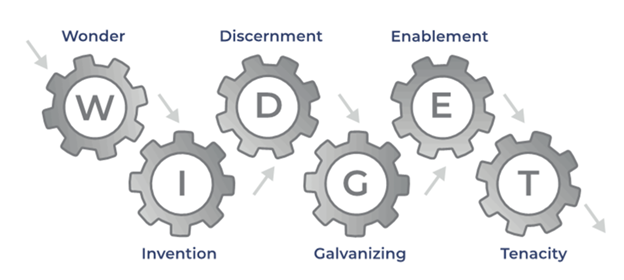Apr 23, 2024
As learning event designers and facilitators, we wield an array of tools to understand our audiences. A pre-event meeting with a participant, the 6 core principles of adult learning, and collaborative guideline-setting before each session are a few of these tools, each uniquely yet cooperatively modeling our participant profiles. There is an additional tool that can offer insight into our learning event audience: The Working Genius.
What is Working Genius?
The Working Genius framework (click here if you are unfamiliar) originates from the mind of organizational leadership expert Patrick Lencioni and his team over at The Table Group. This framework identifies six areas of joy and frustration throughout the cycle of a project (or in our case, a learning activity): Wonder, Invention, Discernment, Galvanizing, Enablement, and Tenacity.

Photo: www.workinggenius.com
Every individual possesses two “working geniuses” and two “working frustrations”. These labels are what one receives joy from and what one does not receive joy from.
For example, one of my colleagues enjoys asking me, “how can we better serve the entrepreneurs on the poverty line through our work at HOPE International?” She is a “wonderer.” I respond enthusiastically with a long list of ideas because I love brainstorming; I am an “inventor” because I receive great joy from ideating. However, don’t ask me too often to choose which of my ideas is best to move forward with – discerning is frustrating to me.
One thing to note is that this framework is not necessarily an indicator of what we are good at, although many times joy and skill are related!
Below are two ways to use Working Genius to enliven learning events.
Facilitate Working Genius language to maximize learning.
Let’s say we design a “world cafe” activity in our learning event. We pose questions on whiteboards around the room and ask small groups to cycle through the questions and brainstorm possible solutions. A dot-mocracy activity might follow, where we encourage participants to analyze the collected responses and add sticky dots next to the ideas that most resonate with them.
These activities line up deliciously with the first three Working Geniuses – Wonder, Invention, and Discernment. In addition to addressing the content discussed, we might pose questions to participants such as: “did you find yourself wondering where these questions came from?” or “did it anger you to have to discern which ideas most resonated with you?”
Employing this shared language adds a new harmonious dimension to the learning event: learners simultaneously learn not just content but team effectiveness techniques as well!
Design using Working Genius to be more inclusive.
Let’s stay with the example above and notice the world cafe and dot-mocracy activities neglect half of the working geniuses and frustrations our participants might have.
As learning event designers, we design for ALL aspects of a solution, ensuring our learning activities cater to as many geniuses as possible including a plan to move forward beyond the learning event.
Are “galvanizers” identified and equipped who will market the new idea that surfaced in the dot-mocracy? Is there a plan following this learning event to actually implement the new idea (for those with the joy of “tenacity”)?
A Final Thought
We as designers and facilitators also benefit from a fresh dimension of inclusivity to consider: sharing where the originating information for the wonderers, including time and resources for an action plan for the galvanizers, designing our evaluation tool so it’s not too open-ended for the tenacity folks.
I hope this new framework intrigues you into accountability for yourself and for a stimulating learning event.
What is coming to mind for you as you consider Working Genius in your work?
Adam Cleland is a Certified Dialogue Education Practitioner and Training Manager for Microfinance Institutions at HOPE International, a faith-based financial services provider to entrepreneurs and families in underserved communities throughout Latin America, Africa, Eastern Europe, and Asia.
Here are some resources for further reading:



